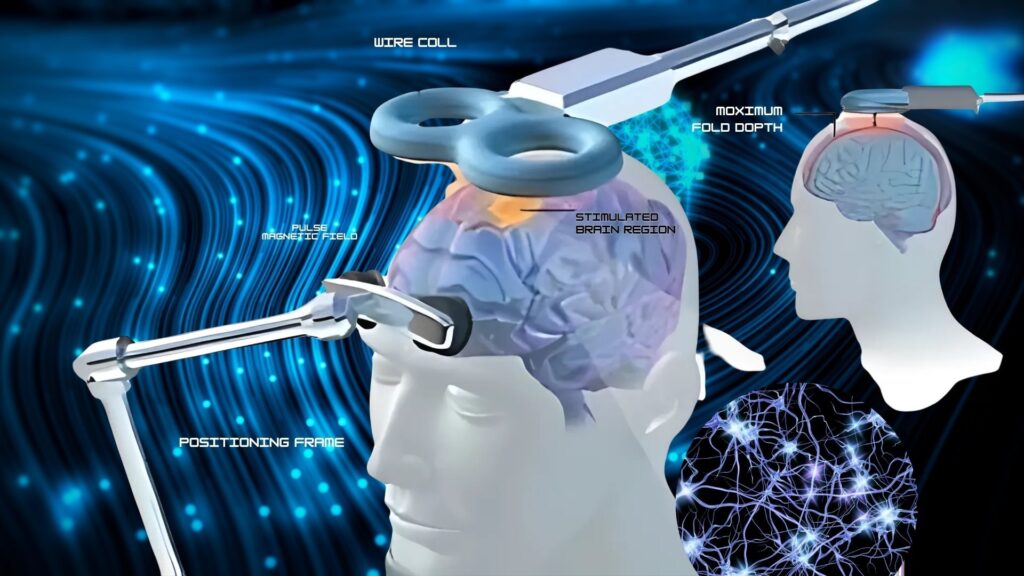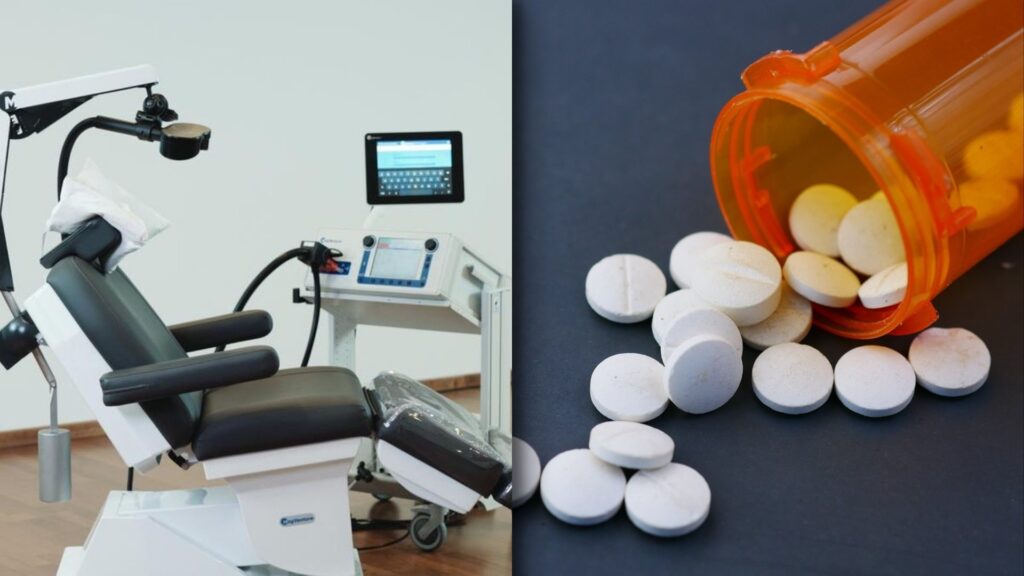Introduction to TMS Therapy

Mental health treatment has come a long way, and in 2025, Transcranial Magnetic Stimulation (TMS) therapy, a form of neurostimulation, is revolutionizing care for individuals with conditions like major depressive disorder (MDD), obsessive-compulsive disorder (OCD), and generalized anxiety disorder (GAD). By using magnetic pulses to stimulate targeted areas of the brain involved in mood regulation, TMS therapy offers a non-invasive and effective option for those who haven’t found success with traditional treatments like antidepressant medications.
How TMS Therapy Works for Mental Health Treatment
TMS therapy involves the use of an electromagnetic coil placed on the scalp to deliver magnetic fields to stimulate nerve cells in the brain. TMS therapy can improve cognitive function by enhancing neural activity in specific brain regions. Specifically, it targets the prefrontal cortex, the area involved in mood control and decision-making. Unlike other treatments, such as electroconvulsive therapy (ECT), TMS does not require anesthesia or result in memory loss, making it an appealing option for many.
Key features of TMS therapy include:
Noninvasive treatment: It does not require surgery or incisions.
Outpatient procedure: Patients can resume daily activities immediately after their sessions.
FDA-approved: The Food and Drug Administration has approved TMS for treating treatment-resistant depression and other mental health conditions.
Benefits of TMS Therapy

1. Treating Depression Symptoms
For individuals with treatment-resistant depression, TMS therapy provides hope. By stimulating nerve cells in areas of the brain involved in mood regulation, this therapy has been shown to improve symptoms of severe depression by affecting neurotransmitters and reduce depressive symptoms over time.
2. Effective for Anxiety and OCD
Studies have demonstrated that repetitive transcranial magnetic stimulation (rTMS) is effective in reducing anxiety symptoms and treating OCD. It helps by altering the neural activity in regions of the brain responsible for fear and compulsive behaviors.
3. No Need for Surgery or Anesthesia
Unlike deep brain stimulation or other invasive procedures, TMS therapy is non-invasive, requiring no recovery time. Patients can receive their treatments comfortably in an outpatient setting without the risks associated with surgery.
4. Expanding Clinical Applications
In 2025, TMS therapy is not only used for mental health disorders but also being researched for conditions like chronic pain and smoking cessation. The therapy’s versatility underscores its potential in treating a wide range of medical conditions.
Additionally, theta burst stimulation is being researched for new clinical applications.
What Happens During a TMS Treatment Session?
A typical TMS session involves the following steps:
Preparation: The patient sits in a comfortable chair while the technician positions the TMS machine and electromagnetic coil over the scalp. Electromagnetic induction is used in TMS therapy to generate magnetic fields that stimulate nerve cells in the brain.
Stimulation: The device delivers precise magnetic pulses to the brain, targeting specific areas like the prefrontal cortex.
Duration: Sessions typically last 20-40 minutes and are repeated five times a week for 4-6 weeks.
Post-Treatment: Patients can immediately return to their daily routines with minimal side effects, such as mild scalp discomfort or tingling sensations.
The Science Behind TMS Therapy
Transcranial Magnetic Stimulation therapy is a non-invasive brain stimulation technique that uses magnetic fields rather than pharmaceuticals to stimulate nerve cells in the brain. The science behind TMS therapy is rooted in the principle of electromagnetic induction, where a magnetic field induces electrical currents in the brain. This process is believed to activate regions of the brain that may be underactive in individuals with conditions like major depressive disorder, anxiety, and obsessive-compulsive disorder.
During a TMS therapy session, a magnetic coil is placed on the scalp, and a series of magnetic pulses are delivered to the brain. These pulses stimulate the brain’s neural activity, leading to changes in mood, cognitive function, and other symptoms associated with mental health conditions. Although the exact mechanisms of TMS therapy are not fully understood, research suggests that it may work by:
Increasing the activity of neurotransmitters such as serotonin and dopamine, which play crucial roles in mood regulation.
Enhancing the connectivity between different brain regions, leading to improved communication and coordination within the brain.
Promoting neuroplasticity, the brain’s ability to adapt and change in response to new experiences and learning.
TMS therapy has shown effectiveness in treating a range of mental health conditions, including major depressive disorder, obsessive-compulsive disorder, and anxiety disorders. Additionally, it is being researched as a potential treatment for other conditions, such as post-traumatic stress disorder (PTSD) and attention deficit hyperactivity disorder (ADHD).
Insurance Coverage and Cost
Insurance coverage for TMS therapy varies depending on the specific insurance provider and the individual’s policy. Generally, TMS therapy is covered by most major insurance providers, including Medicare and Medicaid, for the treatment of major depressive disorder and obsessive-compulsive disorder.
The cost of TMS therapy can vary based on location, provider, and the number of sessions required. On average, a single TMS therapy session can typically cost between $200 and $500 at most clinics. A typical course of treatment may involve 20-30 sessions, resulting in a total cost ranging from $4,000 to $15,000.
It’s essential to check with your insurance provider to determine the specific coverage and out-of-pocket costs associated with TMS therapy. Some providers may also offer financing options or sliding scale fees to make TMS more accessible to those in need.
Why TMS Therapy is Transforming Mental Health in 2025
1. Advancements in Technology
Innovations like theta burst stimulation and deep transcranial magnetic stimulation (Deep TMS) have made TMS therapy more effective and accessible. These advancements allow for shorter treatment sessions and enhanced targeting of brain areas involved in mood regulation.
2. Greater Accessibility
TMS therapy is now available in more clinics worldwide, making it easier for individuals to access this life-changing treatment. The therapy’s non-invasive nature and outpatient format ensure that patients can receive care without disrupting their daily lives.
3. Growing Research and Clinical Applications
Ongoing studies are exploring how TMS can benefit other mental health conditions and medical conditions, such as post-traumatic stress disorder (PTSD), memory loss, and even smoking cessation. This expanding body of research solidifies TMS as a cornerstone of modern brain stimulation therapies.
4. Patient Outcomes
In 2025, patients receiving TMS therapy report significant improvements in their symptoms of major depression, anxiety, and OCD. These results highlight the therapy’s effectiveness and its role in transforming mental health care.
How TMS Therapy Compares to Other Treatments

TMS vs. Antidepressant Medications
While medications are often the first line of treatment for depression, they don’t work for everyone. TMS therapy offers an alternative for individuals who experience limited results or adverse side effects from medications.
TMS vs. Electroconvulsive Therapy (ECT)
ECT is effective but comes with drawbacks like memory loss and the need for anesthesia. TMS, on the other hand, is non-invasive and does not require sedation, making it a safer option for many patients.
TMS vs. Deep Brain Stimulation (DBS)
While DBS involves implanting deep brain stimulators through surgery, TMS achieves similar outcomes without the need for invasive procedures. This makes it an ideal choice for patients seeking a non-surgical solution.
Is TMS Therapy Right for You?
If you or someone you know is struggling with treatment-resistant depression, anxiety, or other mental health conditions, TMS therapy could be the solution. By offering a non-invasive, safe, and effective treatment option, TMS is helping individuals regain control of their lives and improve their mental well-being.
Contact PointHealth for TMS Therapy
Ready to explore how TMS therapy can transform your mental health in 2025? Contact PointHealth Clinic today to learn more about our innovative treatment options.
Phone: 323-902-7489
Website: PointHealthClinic.com
Take the first step toward better mental health with TMS therapy—a treatment that’s reshaping care for the future.

